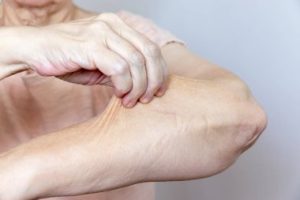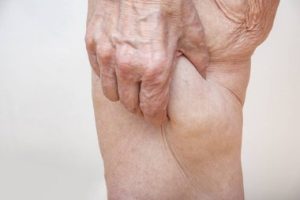
How To Tighten Skin After Weight Loss (3 Helpful Methods)
How to tighten skin after weight loss: Learn the top strategies to tone and rejuvenate your skin post-weight loss. Losing weight is a major achievement, but it often comes with a new challenge—loose, sagging skin. After putting in the hard work to shed those extra pounds, the last thing you want is for your skin to not match your slimmer frame. Fortunately, there are several ways to naturally tighten your skin, from targeted exercises and nourishing skincare routines to non-invasive treatments and lifestyle changes. Whether you’re just starting your weight loss journey or looking to tone up after reaching your goal, learning how to firm up loose skin can help you feel even more confident in your body.

How To Tighten Skin After Weight Loss
To tighten loose skin after weight loss, it’s crucial to focus on a combination of strength training, proper hydration, and skincare routines. Building muscle mass can help fill out areas where fat has been lost, making the skin appear tighter. Additionally, staying hydrated and using skin-firming products can improve skin elasticity. Consistent healthy eating also supports collagen production, helping restore skin’s firmness. Patience is key, as tightening skin naturally takes time.
The Importance of Building Muscle
One of the most effective ways to tighten loose skin after weight loss is by engaging in strength training. Weight loss often results in muscle loss alongside fat reduction, leading to sagging skin. By incorporating resistance exercises, like lifting weights or bodyweight exercises such as squats and push-ups, you can build muscle underneath the skin. Muscle growth increases the overall firmness of your body, as new muscle fills in areas where fat once resided. . Consistent exercise will also boost blood circulation, promoting better skin health and rejuvenation.
Hydration and Skin Elasticity
Water plays a vital role in maintaining skin elasticity. Staying well-hydrated helps the skin retain its natural moisture, making it more supple and less prone to sagging. After significant weight loss, the skin may struggle to bounce back immediately, so drinking plenty of water is critical. Adding foods high in water content, such as cucumbers and melons, to your diet can also support this process.
Skincare Products and Routines
Applying skin-firming lotions and oils, especially those containing collagen, elastin, and hyaluronic acid, can support skin recovery after weight loss. These ingredients help rebuild the skin’s structure and increase its ability to stretch and tighten. Exfoliating regularly can also help by promoting new skin cell production, which can make the skin look tighter over time. Combining these treatments with regular moisturizing routines helps prevent skin from becoming dry and losing its elasticity.
Nutrition and Collagen Production
A balanced diet rich in proteins, vitamins C and E, and antioxidants can support the body’s natural production of collagen, which is essential for firm skin. Collagen is the protein that gives skin its strength and structure, so ensuring you consume enough of it through foods like bone broth, fish, and leafy greens can aid in skin recovery. Vitamin C, found in citrus fruits, also aids in collagen synthesis, making it a valuable nutrient for skin health after weight loss.
Patience and Long-Term Care
Skin tightening after weight loss is not an overnight process. It can take months or even years for the skin to fully adjust to a smaller body size, depending on how much weight was lost and individual factors such as age and genetics. Regular self-care, including healthy habits like exercise, hydration, and proper nutrition, will give your skin the best chance to tighten and regain its firmness naturally over time.

Non-Surgical Methods to Tighten Skin
Strength Training
Non-surgical methods to tighten skin, such as strength training, can significantly improve the appearance of loose skin by promoting muscle development. As muscle builds beneath the skin, it helps fill out areas that may appear saggy, particularly after weight loss. Strength training not only enhances muscle tone but also boosts collagen production, which can increase skin elasticity.
The benefits post-weight loss include improved body contours, a reduction in loose skin, and enhanced overall strength. Key exercises for different body areas include push-ups, dumbbell presses, and bicep curls for the upper body; squats, lunges, and deadlifts for the lower body; and planks and Russian twists for the core. Incorporating resistance bands and weightlifting can add variety and intensity, targeting specific muscles and providing further support for skin tightening.
Cardiovascular Exercise
Regular cardio enhances overall skin health by improving blood circulation, delivering oxygen and nutrients to skin cells, and promoting the removal of toxins. This can result in a more radiant and firm appearance. Some of the best forms of cardio for enhancing skin elasticity include high-intensity interval training (HIIT), swimming, and cycling.
HIIT combines short bursts of intense activity with brief recovery periods, stimulating collagen production while burning fat. Swimming, a low-impact workout, provides resistance that tones muscles while maintaining hydration, which helps prevent sagging. Cycling, another low-impact form of cardio, increases heart rate and circulation, supporting skin health and overall toning without stressing the joints. These activities contribute to healthier, more resilient skin over time.

Nutrition for Skin Health
Non-surgical methods to tighten skin involve a combination of proper nutrition, hydration, and lifestyle habits that support skin health. Hydration plays a crucial role in maintaining skin elasticity, as well-hydrated skin appears plumper and firmer. Key nutrients for skin-tightening include protein, healthy fats, and vitamins A, C, and E, which are essential for collagen production and skin repair.
Consuming collagen-rich foods such as bone broth and gelatin can also promote skin elasticity and reduce sagging. Antioxidants found in fruits, vegetables, and green tea help combat free radicals, supporting skin regeneration and preventing damage. It’s also important to avoid excessive sugar and processed foods, as they can accelerate skin aging by breaking down collagen. Together, these factors can improve skin firmness and overall appearance without the need for surgery.
Skin Care Routines
Non-surgical methods to tighten skin include a combination of effective skincare routines and natural remedies. Regular moisturizing is essential for maintaining skin elasticity, helping to keep it hydrated and more resistant to sagging. Using skin-firming lotions and creams can enhance this process, especially those containing ingredients like retinoids, which stimulate collagen production; hyaluronic acid, which helps retain moisture; and peptides, which support skin structure.
Regular exfoliation is also key, as it removes dead skin cells and promotes the growth of new, firmer skin. Home remedies such as aloe vera, known for its soothing and tightening properties, coconut oil for deep hydration, and coffee scrubs for stimulating blood circulation can further enhance skin tone and texture, offering a natural boost to skin firmness.
Massage Therapy
Non-surgical methods to tighten skin, such as massage therapy, offer a natural and effective approach to improving skin elasticity. Massage improves circulation, enhancing blood flow to the skin, which aids in nutrient delivery and waste removal, ultimately supporting collagen production. Increased collagen helps to firm and tighten the skin over time.
Techniques like dry brushing and oil massage stimulate the lymphatic system and exfoliate the skin, promoting smoother texture and tone. Using a body roller can enhance these benefits by applying targeted pressure, helping to break up fascia, reduce fluid retention, and further stimulate collagen synthesis, resulting in firmer, more toned skin.
Hydration
Non-surgical methods to tighten skin often focus on improving hydration, which plays a key role in maintaining skin elasticity and plumpness. Drinking adequate water helps to hydrate skin from within, supporting its natural barrier function and making it appear fuller and smoother.
Topical hydration, through the use of creams, lotions, and serums, can further enhance this effect by delivering moisture directly to the skin’s surface. Products containing ingredients like hyaluronic acid, glycerin, and ceramides are particularly effective in locking in moisture, promoting a firmer, more youthful appearance. These methods are non-invasive and can improve skin texture over time with consistent use.
Medical and Professional Treatments
Radiofrequency Therapy
Radiofrequency (RF) Therapy is a non-invasive medical and cosmetic treatment that uses energy waves to heat the deeper layers of the skin, specifically targeting the dermis. This heat stimulates the body’s natural collagen production, which is essential for maintaining skin elasticity and firmness. As you age, collagen levels decrease, leading to wrinkles and sagging skin. By promoting collagen production, RF therapy helps to tighten and rejuvenate the skin.
The non-invasive nature of RF therapy makes it a popular choice, as it requires no incisions or downtime, making it convenient for patients. Pros of RF therapy include minimal discomfort, relatively quick procedures, and gradual, natural-looking results. However, cons include the need for multiple sessions to achieve optimal results, potential temporary redness or swelling, and the possibility of variable effectiveness depending on skin type and age.

Ultrasound Therapy
Ultrasound therapy is a non-invasive medical treatment widely used for stimulating the deep layers of the skin, particularly in cosmetic and rehabilitation therapies. By using high-frequency sound waves, this technique targets areas beneath the surface, generating heat that promotes collagen production, skin tightening, and tissue repair.
In medical settings, ultrasound therapy is often applied to areas affected by injury or chronic pain to enhance blood flow, reduce inflammation, and accelerate healing. In cosmetic treatments, it is commonly used to lift and tone sagging skin, especially around the face, neck, and jawline, with results such as improved skin elasticity, reduced wrinkles, and a more youthful appearance typically visible after a few sessions.
Laser Therapy
Laser therapy is a non-invasive medical treatment used to tighten the skin by stimulating collagen production, improving skin elasticity, and reducing fine lines and wrinkles. Lasers work by emitting concentrated beams of light that penetrate the skin’s layers, heating the underlying tissue and causing controlled damage. This process triggers the body’s natural healing response, promoting new collagen formation, which tightens and firms the skin over time.
There are different types of laser treatments, including ablative lasers (such as CO2 and Erbium lasers) that remove outer layers of the skin, and non-ablative lasers (like Nd:YAG and fractional lasers) that target deeper layers without damaging the surface. Recovery time varies depending on the intensity of the treatment—ablative lasers may require several weeks of healing, while non-ablative treatments typically have shorter downtime. Risks include redness, swelling, hyperpigmentation, infection, and scarring, though these are generally rare when performed by experienced professionals.
Micro-Needling
Micro-needling, also known as collagen induction therapy, is a minimally invasive cosmetic procedure that involves the use of fine needles to create micro-injuries on the skin’s surface. This stimulates the body’s natural healing process, encouraging the production of collagen and elastin, proteins essential for maintaining skin’s firmness and elasticity.
The increased collagen can help reduce the appearance of fine lines, wrinkles, scars, and enlarged pores, resulting in smoother, firmer skin. During treatment, a numbing cream is applied to minimize discomfort, and the procedure typically lasts 30 to 60 minutes. Mild redness and sensitivity are common immediately after, but they usually subside within a few days. Micro-needling is suitable for various areas, including the face, neck, décolletage, and hands, making it a versatile treatment for addressing a range of skin concerns across different body parts.

Chemical Peels
Chemical peels are a popular cosmetic procedure used to rejuvenate and firm the skin by applying a chemical solution that exfoliates the outer layers. This process stimulates the production of new, healthy skin cells and collagen, leading to a smoother and more youthful appearance. For effective skin tightening, medium to deep chemical peels are often used, as they penetrate further into the skin layers, addressing more pronounced signs of aging and laxity.
However, deeper peels come with increased risks, such as prolonged redness, irritation, and potential scarring. Proper aftercare is essential to minimize these risks and promote healing, which includes using gentle skin care products, avoiding sun exposure, and following specific instructions provided by a dermatologist or skincare professional.
Body Contouring Treatments
Medical and professional treatments for body contouring offer non-surgical methods to target and reduce stubborn fat deposits and tighten the skin. Techniques such as CoolSculpting and Thermage are popular options. CoolSculpting uses cryolipolysis to freeze and destroy fat cells, which are then naturally eliminated by the body. Thermage, on the other hand, employs radiofrequency energy to stimulate collagen production and tighten the skin.
The primary advantage of these non-surgical methods is that they require minimal downtime and are less invasive compared to surgical procedures like liposuction. However, they may not provide the same level of fat reduction or skin tightening as surgical alternatives and often require multiple sessions to achieve optimal results. Additionally, these treatments can be costly and may not be suitable for everyone, particularly those with significant weight or skin issues.
Surgical Solutions
Skin removal surgery, including procedures such as body lifts, tummy tucks, and arm lifts, is designed to remove excess skin that often results from significant weight loss or aging. Body lifts address sagging skin around the abdomen, thighs, and buttocks, while tummy tucks specifically target the abdominal area, and arm lifts focus on the upper arms.
Candidates for these surgeries are typically individuals who have reached a stable weight and have substantial skin laxity that cannot be corrected through non-surgical methods. Recovery involves a period of rest and limited mobility, with potential risks including infection, scarring, and complications related to anesthesia. Long-term results often include a more contoured and toned appearance, though maintaining results requires ongoing lifestyle management. Overall, these procedures can offer significant physical and emotional benefits, providing a boost in self-esteem and improved body image.
Lifestyle Changes for Maintaining Skin Elasticity
Regular Physical Activity
Maintaining skin elasticity as you age involves a combination of lifestyle changes, with regular physical activity playing a crucial role. Engaging in continued strength and cardio training not only helps to enhance overall health but also promotes circulation, which can benefit skin vitality. Strength training builds muscle tone, which supports the skin, while cardio exercises improve blood flow, delivering essential nutrients to skin cells.
Additionally, incorporating flexibility exercises such as yoga and Pilates into your routine can further aid skin elasticity by enhancing posture and reducing muscle tension. These exercises promote better alignment and balance, which helps maintain a youthful appearance and supports the skin’s natural resilience.
Maintaining a Healthy Diet
Maintaining skin elasticity requires a proactive approach to lifestyle changes, particularly through a healthy diet. Incorporating collagen-boosting foods, such as berries, citrus fruits, leafy greens, and nuts, can significantly enhance skin firmness and resilience. A balanced diet, rich in vitamins A, C, and E, along with adequate hydration, supports collagen production and helps prevent future skin laxity. Regular consumption of these nutrient-dense foods provides essential building blocks for skin repair and regeneration, contributing to a youthful and vibrant appearance over time.

Avoiding Smoking and Excessive Sun Exposure
Maintaining skin elasticity is crucial for a youthful appearance, and lifestyle changes can play a significant role in this. Avoiding smoking is essential, as nicotine restricts blood flow to the skin, depriving it of oxygen and essential nutrients, which accelerates the breakdown of collagen and elastin—key proteins that maintain skin’s firmness and elasticity.
Additionally, excessive sun exposure accelerates collagen breakdown due to harmful UV rays, which can lead to premature aging, wrinkles, and loss of elasticity. To protect the skin, it’s vital to use sunscreen daily with broad-spectrum protection to shield against UVA and UVB rays. Incorporating antioxidant-rich skincare products can also help neutralize free radicals caused by sun exposure and environmental stressors, further supporting skin health and elasticity.
Stress Management
Maintaining skin elasticity is significantly influenced by lifestyle changes, particularly in stress management. Chronic stress has been linked to various skin issues, including reduced elasticity, as it can increase the production of cortisol, which breaks down collagen and elastin in the skin.
Incorporating stress management practices such as meditation and mindfulness can greatly benefit skin health. These practices help lower cortisol levels, promote overall relaxation, and improve blood flow, which can enhance the skin’s ability to repair and regenerate. By reducing stress, individuals can support their skin’s elasticity and overall appearance, contributing to a healthier and more resilient complexion.
Common Misconceptions About Skin Tightening
A common misconception about skin tightening is the belief that loose skin will naturally tighten over time without intervention. While factors such as age, genetics, and skin elasticity play a role in how skin responds, natural tightening may be limited, especially after significant weight loss or aging.
Another prevalent myth is that topical creams can completely resolve loose skin. Although certain creams can improve skin texture and hydration, they cannot fundamentally alter skin laxity. Additionally, some people think surgery is the only effective solution for loose skin, but non-surgical methods like radiofrequency treatments, ultrasound therapy, and laser treatments can offer significant improvements for many individuals, depending on their specific needs and skin condition.
Emotional and Psychological Impact of Loose Skin After Weight Loss
Loose skin after significant weight loss can have profound emotional and psychological effects. Many individuals face body image challenges as they adjust to their new appearance, often struggling with a diminished sense of self-esteem despite their achievements. The presence of loose skin can exacerbate feelings of insecurity and frustration, as the physical changes may not align with the hard work and dedication put into the weight loss journey.
This struggle can also impact social interactions and relationships, leading to self-consciousness in social settings or activities. To navigate these emotional hurdles, seeking support from communities, therapists, or support groups can be crucial. Engaging with others who share similar experiences can provide comfort and understanding, while professional guidance can help in addressing deeper psychological impacts. Maintaining a positive mindset and recognizing the accomplishment of achieving weight loss goals are essential for fostering emotional resilience and overall well-being.
FAQ: How To Tighten Skin After Weight Loss
Q1. Why does loose skin occur after weight loss?
A. Loose skin often occurs after weight loss because the skin has been stretched for an extended period and loses elasticity. When you lose a significant amount of weight, the skin may not retract fully, especially if the loss is rapid or the skin was stretched for a long time.
Q2. Can I tighten loose skin without surgery?
A. Yes, it is possible to improve the appearance of loose skin without surgery through consistent exercise, proper hydration, nutrition, and certain skincare techniques. While it may not restore complete firmness, these methods can help tighten and tone the skin.
Q3. How does exercise help tighten skin after weight loss?
A. Strength training exercises, in particular, help build muscle mass beneath the skin, which can reduce the appearance of sagging by filling out loose areas. Resistance training also boosts collagen production, which can improve skin elasticity.
Q4. What are some natural remedies to tighten skin?
A. Natural remedies to promote skin tightening include staying hydrated, eating a diet rich in vitamins and collagen-boosting foods (like vitamin C and protein), dry brushing to improve circulation, and applying firming creams that contain ingredients like retinol or hyaluronic acid.
Q5. Can collagen supplements help with loose skin?
A. Collagen supplements may support skin health by boosting collagen production, which is crucial for skin elasticity. While they may not completely eliminate loose skin, they can contribute to improved skin firmness and texture.
Q6. Will weightlifting make loose skin worse?
A. No, weightlifting can actually help improve the appearance of loose skin. Building muscle mass helps to firm up the areas where the skin may appear saggy, and resistance training can increase skin elasticity over time.
Q7. How long does it take to see improvements in skin firmness?
A. The time it takes to see improvements varies depending on factors like age, genetics, the amount of weight lost, and how long the skin was stretched. With consistent exercise, proper hydration, and a nutrient-rich diet, improvements can be seen over several months, though full results may take longer.
Q8. What role does hydration play in skin elasticity?
A. Hydration is essential for maintaining healthy skin. Water helps keep the skin plump and supports the natural elasticity of the skin. Staying hydrated can improve skin texture and prevent it from appearing dry or saggy.
Q9. Is surgery the only option for severely loose skin?
A. For some individuals with a large amount of excess skin, surgery such as a body lift or tummy tuck may be the only option to achieve the desired results. However, these procedures come with risks, and non-invasive options should be considered first.
Q10. Can skin tightening treatments like lasers or radiofrequency help?
A. Yes, non-surgical treatments such as laser therapy, radiofrequency, or ultrasound can help stimulate collagen production and tighten the skin. These treatments are often effective for mild to moderate skin laxity and can provide noticeable results with minimal downtime.
Q11. Are there specific foods that help tighten skin?
A. Foods rich in vitamins A, C, E, and omega-3 fatty acids support skin health and elasticity. Collagen-rich foods like bone broth, and those containing antioxidants, such as berries and leafy greens, also help protect and tighten skin.
Q12. Does age affect the ability to tighten loose skin?
A. Yes, age plays a role in skin elasticity. Younger individuals tend to have more elastic skin, which can bounce back more easily after weight loss. As we age, the skin naturally loses some of its ability to retract, which can make it harder to tighten loose skin.
Q13. What skincare products can help firm up loose skin?
A. Look for skincare products that contain ingredients like retinol, peptides, hyaluronic acid, and vitamin C, which are known to improve skin elasticity, promote collagen production, and provide hydration for firmer skin.
Q14. How can I prevent loose skin during weight loss?
A. To minimize the risk of loose skin during weight loss, aim for a slow, steady weight loss process. Incorporate strength training into your routine to build muscle, stay hydrated, eat a balanced diet rich in collagen-boosting nutrients, and use moisturizers to maintain skin hydration.
Conclusion
After weight loss, tightening loose skin can be achieved through a combination of strategies, including strength training, proper hydration, a nutrient-rich diet, and sometimes medical treatments. Exercise, particularly resistance training, can help build muscle to fill out the skin and improve overall tone. Eating foods rich in collagen, vitamin C, and other skin-supporting nutrients aids in skin elasticity and repair.
Staying hydrated keeps the skin supple, while body massages and skin care products may also help improve skin texture. For more dramatic results, procedures like skin tightening treatments or surgery may be necessary. Ultimately, patience is key, as skin naturally adjusts to body changes over time.